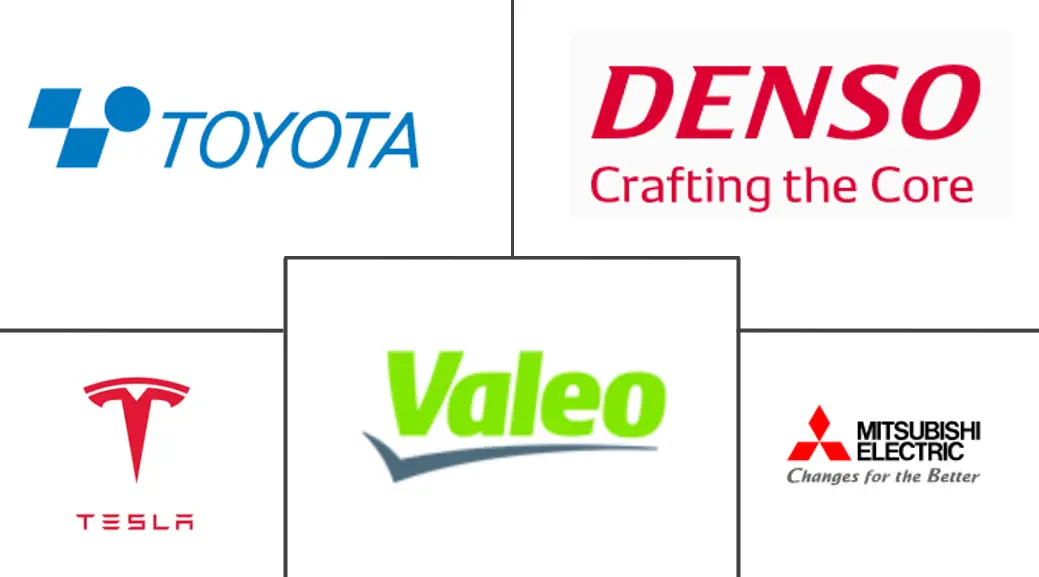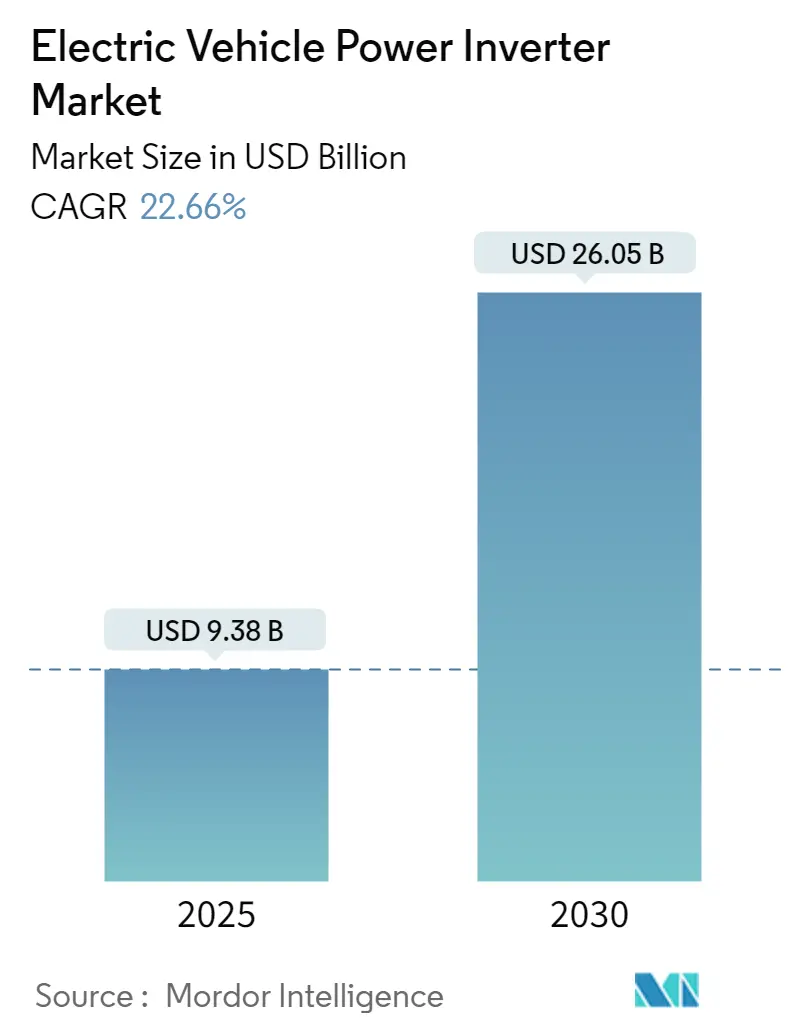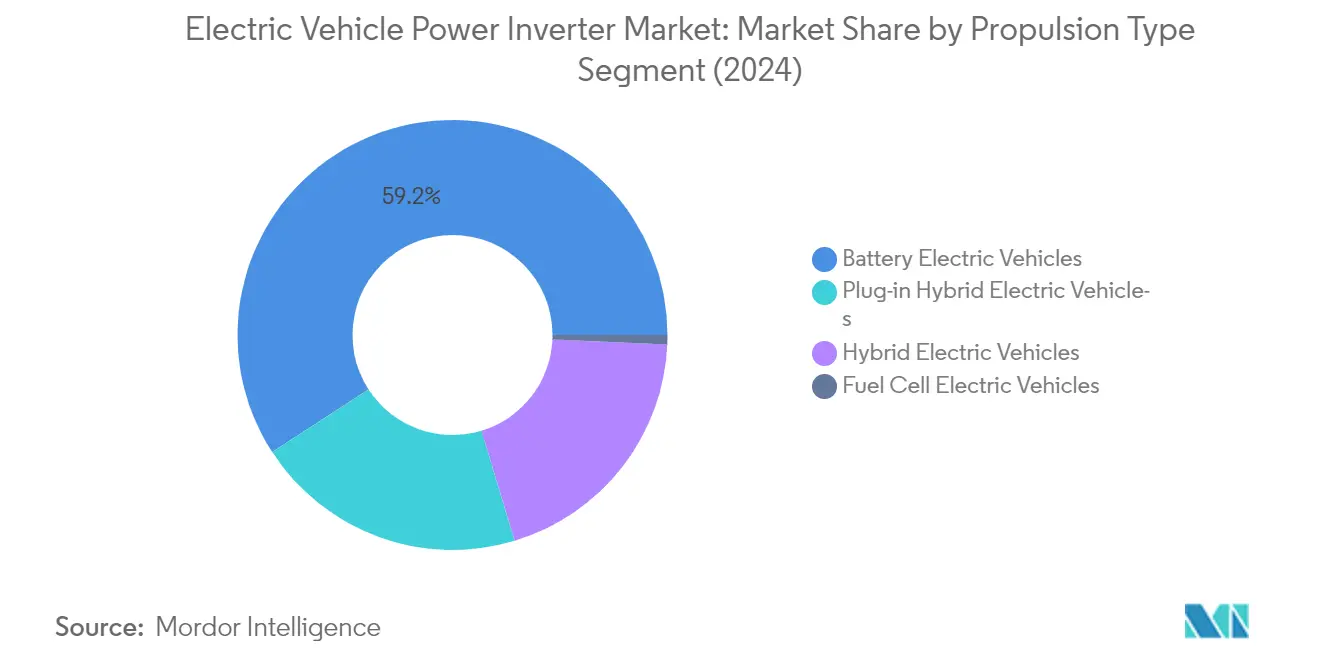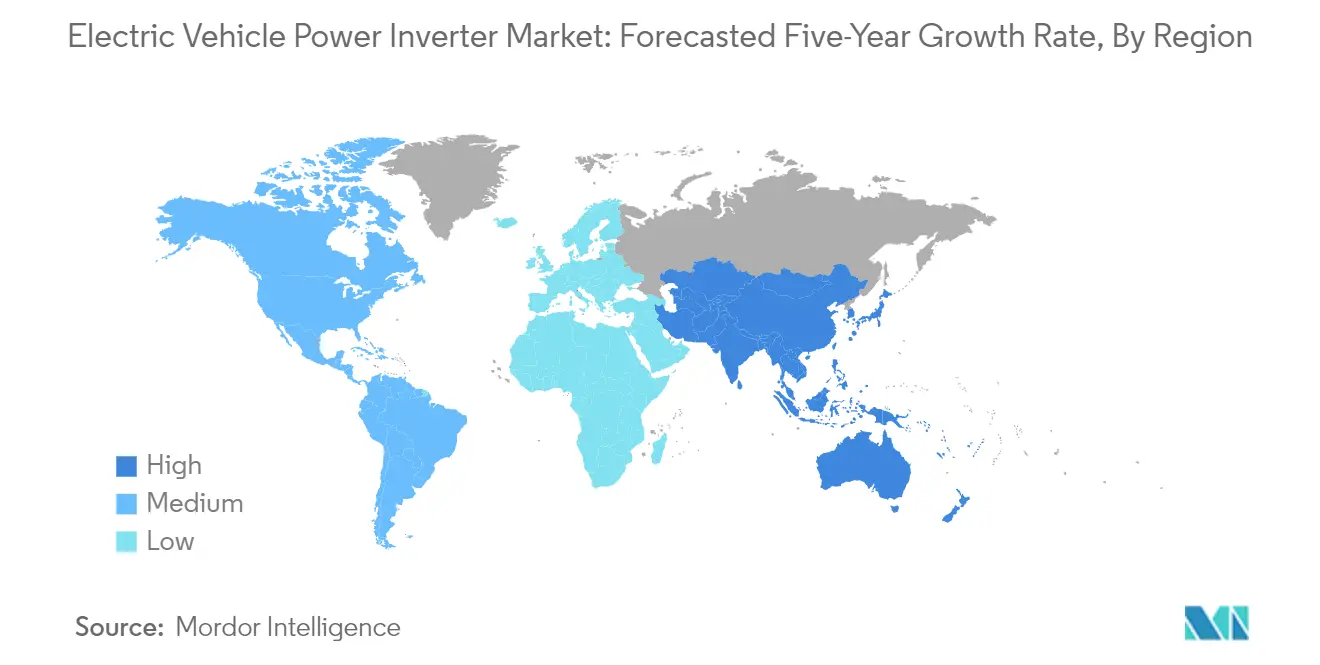EV Power Inverter Market Analysis
The Electric Vehicle Power Inverter Market size is estimated at USD 9.38 billion in 2025, and is expected to reach USD 26.05 billion by 2030, at a CAGR of 22.66% during the forecast period (2025-2030).
The electric vehicle power inverter industry is experiencing transformative growth driven by unprecedented manufacturer commitments and technological advancements. Major automotive manufacturers are substantially increasing their investments in electric vehicle development, with companies like General Motors announcing plans to invest USD 20 billion by 2025 for electric and autonomous vehicles, aiming to launch 20 new electric models. This strategic shift is complemented by ambitious production targets, with Volkswagen planning for 70% of its European sales and 50% of U.S. and Chinese sales to be electric vehicles by 2030. These commitments are reshaping the industry landscape and driving innovation in electric vehicle inverter technology.
The market is witnessing a significant evolution in manufacturing capabilities and supply chain optimization. Ford has announced plans to invest USD 30 billion in electric vehicle development through 2025, while also transforming its Cologne facility into an electrification center with an investment of USD 1 billion. This trend is particularly evident in the commercial vehicle sector, where manufacturers are expanding their production capabilities to meet growing demand. The industry is seeing increased collaboration between traditional automotive manufacturers and technology companies, leading to more efficient and advanced EV inverter manufacturers solutions.
Government initiatives and infrastructure development are playing crucial roles in market expansion. In the United Kingdom, companies are expected to invest more than GBP 12 billion in switching their fossil fuel vehicles to clean electric versions. This transition is supported by various government policies and incentives across different regions. The transformation is particularly evident in public transportation, with cities like Panama investing USD 35 million in 195 electric buses, demonstrating the growing commitment to electrification in public transport systems.
The industry is experiencing rapid technological advancement in power inverter design and efficiency. Manufacturers are focusing on developing more compact, efficient, and cost-effective inverter solutions. Companies like BorgWarner are expanding their facilities, such as the second phase expansion of their Suzhou Industrial Park, to enhance research and development capabilities in power electronics, including inverters and DC/DC converters. This focus on innovation is driving improvements in power density, thermal management, and overall system efficiency, leading to better performance and reduced costs for automotive inverter manufacturers.
EV Power Inverter Market Trends
Increasing Sales of Electric Vehicles
The rapid acceleration in electric vehicle adoption worldwide has created a substantial demand for EV power inverter systems, which are crucial components in electric vehicle powertrains. Global battery electric vehicle sales reached a significant milestone of 3.5 million units in 2021, demonstrating the increasing consumer acceptance of electric mobility solutions. This surge in EV adoption is primarily driven by rising environmental consciousness among consumers and the global push toward achieving energy efficiency while reducing greenhouse gas emissions. The growing demand for electric vehicles has necessitated improvements in power electronics, particularly inverters, as manufacturers focus on enhancing vehicle performance while managing battery costs.
The shift in consumer preference towards electric vehicles has prompted automotive manufacturers to expand their electric vehicle portfolios, directly impacting the demand for electric car inverter technologies. This transition is further supported by the development of charging infrastructure, with major initiatives such as Japan's target to establish 150,000 charging stations by 2030 and ENECHANGE Ltd's commitment to install 30,000 EV chargers by 2027. The increasing focus on fast-charging technologies and the need for more efficient power conversion systems has led manufacturers to develop advanced inverter technologies, creating opportunities for innovation in the automotive inverter market. Additionally, the rising global fuel prices have accelerated the adoption of electric vehicles, particularly in regions with developed charging infrastructure, further driving the demand for power inverters.
Increasing Investments in Electric Vehicles
The electric vehicle industry is witnessing substantial investments from both automotive manufacturers and governments, creating a robust ecosystem for electric vehicle power converter development and production. Major automotive companies are making significant investments in electric vehicle technology and component manufacturing, exemplified by Toyota Group's investment of ₹48 billion for electric vehicle components and Suzuki Motor's commitment of ₹10,440 crore for new electric car and battery facilities in India. These investments are complemented by government initiatives, such as Germany's €6.3 billion investment in charging infrastructure development, which collectively strengthen the electric vehicle ecosystem and drive demand for EV motor inverter solutions.
The formation of strategic partnerships and collaborations among industry players is further accelerating technological advancement in power inverter development. For instance, the strategic collaboration between Sony Group Corporation and Honda Motor Co., Ltd for developing high-value-added battery electric vehicles demonstrates the industry's commitment to advancing electric vehicle technology. These partnerships often focus on improving power electronics and drivetrain efficiency, leading to innovations in inverter technology. Furthermore, companies are increasing their R&D expenditure in electric vehicles and associated components, with manufacturers like BorgWarner receiving contracts for developing scalable ultra power-dense extended range inverters, highlighting the industry's focus on technological advancement in power inverter solutions. The continuous investment in research and development is enabling manufacturers to create more efficient, compact, and cost-effective inverter solutions for the growing electric vehicle market.
Segment Analysis: By Propulsion Type
Battery Electric Vehicle Segment in Electric Vehicle Power Inverter Market
The Battery Electric Vehicle (BEV) segment dominates the global electric vehicle power inverter market, commanding approximately 59% market share in 2024. This significant market position is driven by the increasing global adoption of pure electric vehicles across both passenger and commercial segments. Major automotive manufacturers are expanding their BEV portfolios and investing heavily in electric vehicle technology development. The segment's growth is further supported by improving battery technologies, expanding charging infrastructure, and favorable government policies promoting zero-emission vehicles. Additionally, the continuous advancement in vehicle power inverter technology for BEVs, focusing on higher efficiency and power density, has strengthened this segment's market position.
Plug-in Hybrid Electric Vehicle Segment in Electric Vehicle Power Inverter Market
The Plug-in Hybrid Electric Vehicle (PHEV) segment is emerging as the fastest-growing segment in the electric vehicle power inverter market, with an expected growth rate of approximately 26% during 2024-2029. This remarkable growth is attributed to the segment's unique position in bridging the transition from conventional to fully electric vehicles. PHEVs are gaining popularity among consumers who seek the benefits of electric mobility while maintaining the flexibility of traditional internal combustion engines. The segment's growth is further accelerated by technological advancements in hybrid vehicle inverter systems specifically designed for dual-power source vehicles, improved battery management systems, and increasing consumer preference for vehicles with extended range capabilities.
Remaining Segments in Electric Vehicle Power Inverter Market by Propulsion Type
The remaining segments in the market include Hybrid Electric Vehicles (HEV) and Fuel Cell Electric Vehicles (FCEV). The HEV segment maintains a substantial presence in the market, particularly in regions with established hybrid vehicle markets and where full electrification infrastructure is still developing. Meanwhile, the FCEV segment, though currently smaller, represents an important technological frontier in the electric vehicle market, particularly for commercial and heavy-duty applications. Both segments contribute to the diverse landscape of electric vehicle propulsion technologies, each serving specific market needs and regional preferences while driving innovations in vehicle power inverter technology.
Segment Analysis: By Vehicle Type
Passenger Cars Segment in Electric Vehicle Power Inverter Market
The passenger cars segment dominates the electric vehicle power inverter market, commanding approximately 80% of the total market share in 2024. This significant market position is primarily driven by the increasing adoption of electric passenger vehicles across major automotive markets worldwide. The segment's growth is further supported by substantial investments from leading automotive manufacturers in expanding their electric vehicle portfolios and developing advanced electric car power inverter technologies. Major automakers are focusing on launching new battery electric and plug-in hybrid models, which has created a robust demand for power inverters in the passenger car segment. The market is also benefiting from supportive government policies and incentives promoting electric vehicle adoption, particularly in regions like Europe, China, and North America.
Commercial Vehicles Segment in Electric Vehicle Power Inverter Market
The commercial vehicles segment is emerging as the fastest-growing segment in the EV power inverter market, with a projected growth rate of approximately 25% during 2024-2029. This accelerated growth is primarily driven by the increasing electrification of public transportation fleets and commercial delivery vehicles across major global markets. Transit agencies and logistics companies are increasingly transitioning their fleets to electric vehicles to reduce operational costs and meet stringent emission regulations. The segment is witnessing significant technological advancements in power inverter systems specifically designed for commercial vehicle applications, offering improved efficiency and performance. The growth is further supported by government initiatives promoting the adoption of electric buses and trucks, particularly in urban areas focusing on sustainable transportation solutions.
Electric Vehicle Power Inverter Market Geography Segment Analysis
Electric Vehicle Power Inverter Market in North America
The North American electric vehicle power inverter market demonstrates robust growth driven by the increasing adoption of electric vehicles across the United States and Canada. The region benefits from strong government support through incentives and infrastructure development for electric mobility. Advanced manufacturing capabilities and the presence of major automotive OEMs contribute to the market's expansion. The increasing focus on reducing emissions and transitioning to sustainable transportation solutions has created favorable conditions for electric vehicle component manufacturers, including automotive inverter suppliers.
Electric Vehicle Power Inverter Market in United States
The United States leads the North American market with approximately 86% share of the regional market in 2024. The country's dominance is supported by the presence of established automotive manufacturers and their increasing investment in electric vehicle production. The market benefits from advanced research and development facilities, strong technological infrastructure, and growing consumer acceptance of electric vehicles. Various automobile manufacturers are actively working on electric vehicle concepts and prototypes, with several new models scheduled for launch. The collaboration between technology companies and automotive manufacturers has led to innovations in electric vehicle inverter technology, enhancing overall market growth.
Electric Vehicle Power Inverter Market in Canada
Canada emerges as the fastest-growing market in North America with a projected growth rate of approximately 24% during 2024-2029. The country's market is characterized by increasing adoption of electric vehicles in both passenger and commercial segments. The federal government's commitment to sustainable transportation through various initiatives and policies has created a favorable environment for market growth. The country's focus on developing electric vehicle infrastructure and manufacturing capabilities has attracted investments from major automotive players. Canadian markets show particular strength in commercial electric vehicles, with several manufacturers planning to introduce new electric truck models, thereby increasing the demand for traction inverter solutions.
Electric Vehicle Power Inverter Market in Europe
The European electric vehicle power inverter market showcases significant growth potential, driven by stringent emission regulations and strong government support for electric mobility. The region's market is characterized by the presence of major automotive manufacturers in Germany, the United Kingdom, France, and Italy, who are increasingly focusing on electric vehicle production. The European Union's push towards carbon neutrality has accelerated the adoption of electric vehicles, consequently driving the demand for EV inverter solutions. The region benefits from advanced technological infrastructure and strong research and development capabilities in the automotive sector.
Electric Vehicle Power Inverter Market in Germany
Germany maintains its position as the largest market in Europe, commanding approximately 21% of the regional market share in 2024. The country's market leadership is underpinned by its strong automotive manufacturing base and technological expertise in electric vehicle components. German automakers' significant investments in electric vehicle development and production have created substantial demand for automotive inverter solutions. The presence of major automotive suppliers and their focus on research and development has fostered innovations in power inverter technology. The country's well-established electric vehicle ecosystem and infrastructure support continue to drive market growth.
Electric Vehicle Power Inverter Market in Italy
Italy emerges as the fastest-growing market in Europe with an expected growth rate of approximately 24% during 2024-2029. The Italian market demonstrates strong potential in electric vehicle adoption, particularly in urban areas. The country's automotive industry is actively transitioning towards electric mobility, with increasing investments in electric vehicle production and component manufacturing. Government initiatives promoting electric vehicle adoption and the development of charging infrastructure have created favorable conditions for market growth. The country's strategic position in the European automotive supply chain further supports its rapid market expansion, particularly in the power inverter for electric vehicles sector.
Electric Vehicle Power Inverter Market in Asia-Pacific
The Asia-Pacific region represents a significant market for electric vehicle power inverters, with major contributions from China, Japan, India, and South Korea. The region's market is characterized by rapid industrialization, increasing automotive production capabilities, and strong government support for electric mobility. The presence of major automotive manufacturers and their focus on electric vehicle production creates substantial demand for EV inverter solutions. The region benefits from advanced manufacturing capabilities and growing investments in electric vehicle technology.
Electric Vehicle Power Inverter Market in China
China maintains its position as the dominant market in the Asia-Pacific region, driven by its massive electric vehicle production capacity and strong domestic market demand. The country's leadership in electric vehicle adoption is supported by comprehensive government policies and incentives. Chinese automotive manufacturers' increasing focus on electric vehicle production and the presence of major component suppliers contribute to market growth. The country's well-developed supply chain for electric vehicle components and strong manufacturing capabilities further strengthen its market position, particularly in the traction inverter segment.
Electric Vehicle Power Inverter Market in India
India emerges as the fastest-growing market in the Asia-Pacific region, driven by increasing government support for electric mobility and growing investments in electric vehicle manufacturing. The country's automotive industry is rapidly transitioning towards electric vehicles, with several domestic and international manufacturers establishing production facilities. The government's push for electric vehicle adoption through various policies and incentives creates favorable conditions for market growth. The country's growing focus on developing local manufacturing capabilities for electric vehicle components further supports market expansion, particularly in the EV inverter market.
Electric Vehicle Power Inverter Market in Rest of the World
The Rest of the World market, comprising South America and the Middle East & Africa, shows emerging potential in the electric vehicle power inverter sector. These regions are witnessing increasing adoption of electric vehicles, particularly in public transportation and commercial vehicle segments. South America, led by Brazil, demonstrates growing interest in electric mobility, with several countries implementing supportive policies and infrastructure development initiatives. The Middle East & Africa region is gradually embracing electric mobility, with countries like the United Arab Emirates and Saudi Arabia making significant investments in electric vehicle infrastructure. South America emerges as the largest market in this region, while the Middle East & Africa shows the fastest growth potential, driven by increasing investments in sustainable transportation solutions.
EV Power Inverter Industry Overview
Top Companies in Electric Vehicle Power Inverter Market
The electric vehicle power inverter market is characterized by intense innovation and strategic positioning among key players like DENSO Corporation, Toyota Industries, Mitsubishi Electric, BYD Auto, and Continental AG. Companies are heavily investing in research and development to advance their technological capabilities, particularly in areas like silicon carbide (SiC) inverters and high-voltage systems. The industry witnesses frequent strategic partnerships and collaborations aimed at developing next-generation power electronics solutions, with many players establishing joint ventures to combine their expertise. Operational agility is demonstrated through the establishment of regional manufacturing facilities and technical centers to serve local markets effectively. Market leaders, including manufacturers of automotive inverters, are expanding their production capacities and establishing new facilities across key automotive manufacturing regions while simultaneously developing comprehensive product portfolios that cater to various vehicle segments and power requirements.
Consolidated Market with Strong Regional Players
The electric vehicle power inverter market exhibits a moderately consolidated structure dominated by large automotive component manufacturers and specialized power electronics companies. Global conglomerates with diverse automotive portfolios maintain significant market presence through their established relationships with major OEMs and extensive distribution networks. These companies leverage their manufacturing scale and technological expertise to maintain competitive advantages. Regional players, particularly in Asia-Pacific, have carved out strong positions in their domestic markets through close partnerships with local automotive manufacturers and government support programs.
The market is witnessing increased consolidation through strategic mergers and acquisitions, as companies seek to enhance their technological capabilities and expand their geographic footprint. Major players are acquiring specialized electronics firms and forming strategic alliances to strengthen their position in the rapidly evolving electric vehicle ecosystem. The industry structure is further shaped by vertical integration efforts, with some automotive manufacturers developing in-house inverter manufacturing capabilities while others maintain strong relationships with specialized manufacturers of electric vehicle inverters.
Innovation and Integration Drive Market Success
Success in the electric vehicle power inverter market increasingly depends on companies' ability to develop advanced technological solutions while maintaining cost competitiveness. Incumbent players must focus on continuous innovation in areas such as power density improvement, efficiency optimization, and thermal management while simultaneously scaling up production to achieve economies of scale. Building strong relationships with automotive OEMs through early engagement in vehicle development programs and maintaining high-quality standards are crucial for maintaining market position. Companies must also invest in developing comprehensive service networks and technical support capabilities to address the growing complexity of electric vehicle systems.
For new entrants and emerging players, success lies in identifying specific market niches and developing specialized solutions that address unique customer requirements. Companies must navigate the high entry barriers posed by established player relationships and significant capital requirements while building credibility through strategic partnerships and demonstrated technological expertise. The regulatory landscape, particularly regarding vehicle electrification and emissions standards, continues to shape market opportunities and drive innovation requirements. The concentrated nature of the automotive OEM customer base necessitates strong relationship management capabilities and the ability to meet stringent quality and reliability requirements. Manufacturers of EV inverters are particularly focused on these aspects to ensure their solutions meet the evolving demands of the market.
EV Power Inverter Market Leaders
-
DENSOCorporation
-
Mitsubishi Electric Corporation
-
Tesla, Inc.
-
Toyota Industries Corporation
-
Valeo SA
- *Disclaimer: Major Players sorted in no particular order
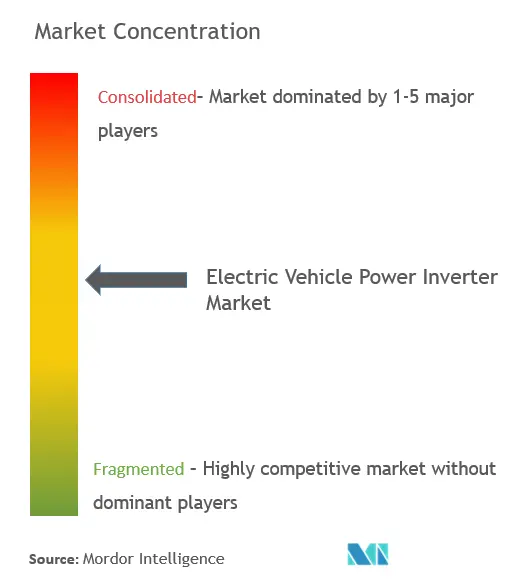
EV Power Inverter Market News
- June 2024: Cissoid is supplying SiC-based inverter modules to Applied EV for its autonomous electric vehicles in industrial settings.
- June 2024: ABB launched the AMXE250 motor and HES580 three-level inverter package tailored for electric buses, designed to minimize motor losses by up to 12% compared to previous technologies over typical drive cycles.
- January 2024: Mitsubishi Electric Corporation introduced six new J3-Series power semiconductor modules for xEVs, featuring SiC-MOSFET or RC-IGBT designs, enhancing efficiency and scalability in EV and PHEV inverters.
EV Power Inverter Market Report - Table of Contents
1. INTRODUCTION
- 1.1 Study Assumptions
- 1.2 Scope of the Study
2. RESEARCH METHODOLOGY
3. EXECUTIVE SUMMARY
4. MARKET DYNAMICS
-
4.1 Market Drivers
- 4.1.1 Rising Demand for Electric Vehicles Is Expected to Increase the Demand
-
4.2 Market Restraints
- 4.2.1 Infrastructure Challenges May Possess Operational Challenges
-
4.3 Industry Attractiveness - Porter's Five Forces Analysis
- 4.3.1 Bargaining Power of Suppliers
- 4.3.2 Bargaining Power of Buyers/Consumers
- 4.3.3 Threat of New Entrants
- 4.3.4 Threat of Substitute Products
- 4.3.5 Intensity of Competitive Rivalry
5. MARKET SEGMENTATION (Market Size in Value - USD)
-
5.1 By Propulsion Type
- 5.1.1 Hybrid Electric Vehicles
- 5.1.2 Plug-in Hybrid Electric Vehicle
- 5.1.3 Battery Electric Vehicle
- 5.1.4 Fuel Cell Electric Vehicle
-
5.2 By Vehicle Type
- 5.2.1 Passenger Cars
- 5.2.2 Commercial Vehicles
-
5.3 Geography
- 5.3.1 North America
- 5.3.1.1 United States
- 5.3.1.2 Canada
- 5.3.1.3 Rest of North America
- 5.3.2 Europe
- 5.3.2.1 Germany
- 5.3.2.2 United Kingdom
- 5.3.2.3 France
- 5.3.2.4 Italy
- 5.3.2.5 Rest of Europe
- 5.3.3 Asia-Pacific
- 5.3.3.1 China
- 5.3.3.2 Japan
- 5.3.3.3 India
- 5.3.3.4 South Korea
- 5.3.3.5 Rest of Asia-Pacific
- 5.3.4 Rest of the World
- 5.3.4.1 South America
- 5.3.4.2 Middle East and Africa
6. COMPETITIVE LANDSCAPE
- 6.1 Vendor Market Share
-
6.2 Company Profiles
- 6.2.1 Vitesco Technologies
- 6.2.2 Robert Bosch GmbH
- 6.2.3 DENSO Corporation
- 6.2.4 Toyota Industries Corporation
- 6.2.5 Hitachi Astemo Ltd
- 6.2.6 Meidensha Corporation
- 6.2.7 Aptiv PLC (Borgwarner Inc.)
- 6.2.8 Mitsubishi Electric Corporation
- 6.2.9 Marelli Corporation
- 6.2.10 Valeo Group
- 6.2.11 Lear Corporation
- 6.2.12 Infineon Technologies AG
- 6.2.13 Eaton Corporation
- *List Not Exhaustive
7. MARKET OPPORTUNITIES AND FUTURE TRENDS
- 7.1 Integration of Bidirectional Charging
- 7.2
EV Power Inverter Industry Segmentation
The electric power inverter is a device installed in an electric vehicle to convert high-power DC to AC. The converter current is further utilized by motors to run several other AC-compatible devices and sensors.
The electric vehicle power inverter market is segmented by propulsion type, vehicle type, and geography. By propulsion type, the market is segmented into hybrid electric vehicles, plug-in hybrid vehicles, battery electric vehicles, and fuel cell electric vehicles. By vehicle Type, the market is segmented into passenger cars and commercial vehicles. By Geography, the market is segmented into North America, Europe, Asia-Pacific, and the rest of the world. The report offers market size and forecasts in terms of value (USD) for all the above segments.
| By Propulsion Type | Hybrid Electric Vehicles | ||
| Plug-in Hybrid Electric Vehicle | |||
| Battery Electric Vehicle | |||
| Fuel Cell Electric Vehicle | |||
| By Vehicle Type | Passenger Cars | ||
| Commercial Vehicles | |||
| Geography | North America | United States | |
| Canada | |||
| Rest of North America | |||
| Europe | Germany | ||
| United Kingdom | |||
| France | |||
| Italy | |||
| Rest of Europe | |||
| Asia-Pacific | China | ||
| Japan | |||
| India | |||
| South Korea | |||
| Rest of Asia-Pacific | |||
| Rest of the World | South America | ||
| Middle East and Africa | |||
EV Power Inverter Market Research FAQs
How big is the Electric Vehicle Power Inverter Market?
The Electric Vehicle Power Inverter Market size is expected to reach USD 9.38 billion in 2025 and grow at a CAGR of 22.66% to reach USD 26.05 billion by 2030.
What is the current Electric Vehicle Power Inverter Market size?
In 2025, the Electric Vehicle Power Inverter Market size is expected to reach USD 9.38 billion.
Who are the key players in Electric Vehicle Power Inverter Market?
DENSOCorporation, Mitsubishi Electric Corporation, Tesla, Inc., Toyota Industries Corporation and Valeo SA are the major companies operating in the Electric Vehicle Power Inverter Market.
Which is the fastest growing region in Electric Vehicle Power Inverter Market?
Europe is estimated to grow at the highest CAGR over the forecast period (2025-2030).
Which region has the biggest share in Electric Vehicle Power Inverter Market?
In 2025, the Asia-Pacific accounts for the largest market share in Electric Vehicle Power Inverter Market.
What years does this Electric Vehicle Power Inverter Market cover, and what was the market size in 2024?
In 2024, the Electric Vehicle Power Inverter Market size was estimated at USD 7.25 billion. The report covers the Electric Vehicle Power Inverter Market historical market size for years: 2019, 2020, 2021, 2022, 2023 and 2024. The report also forecasts the Electric Vehicle Power Inverter Market size for years: 2025, 2026, 2027, 2028, 2029 and 2030.
Our Best Selling Reports
Electric Vehicle Power Inverter Market Research
Mordor Intelligence offers extensive expertise in analyzing the electric vehicle power inverter market. We provide comprehensive insights into automotive inverter manufacturers and emerging technologies. Our detailed research covers the complete spectrum, from traction inverter systems to power inverter solutions. It includes electric vehicle inverter testing methodologies and manufacturing processes. The report provides an in-depth analysis of EV inverter technologies and automotive on-board power inverter systems. It also explores the evolving landscape of hybrid vehicle inverter applications. This information is available as an easy-to-download report PDF.
Stakeholders benefit from our thorough examination of power inverter manufacturer capabilities and e-mobility inverter testing protocols. We cover technological advancements in electric vehicle power converter systems. The analysis encompasses developments in industrial high voltage inverter, propulsion inverters, and EV motor inverter innovations. Our research delivers actionable insights into electric car inverter technologies and vehicle power inverter trends. It highlights the growing importance of power conversion system inverter solutions in the automotive sector. This is supported by extensive data on inverter automotive applications and EV inverter manufacturers.

